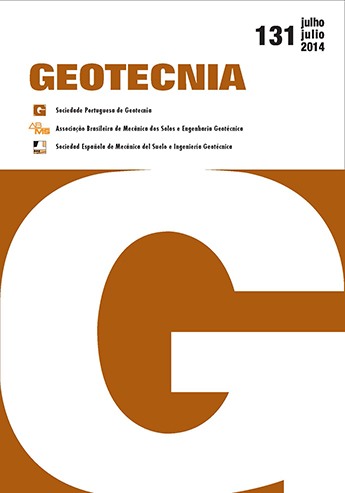Reinforcement with Deep Soil Mixing of the soft soil foundation of an embankment. Modelling of a case study
DOI:
https://doi.org/10.24849/j.geot.2014.131.05Keywords:
Deep Soil Mixing (DSM), Embankment on soft soil, Numerical modellingAbstract
In the present work an embankment on soft soil is analyzed with commercial finite element software (Plaxis®) in order to compare the solution implemented on site (with drains and preloading) with a soil improvement solution in Deep Soil Mixing (DSM). Several alternative solutions in DSM were studied changing the column spacing, the curing time, as well as the inclusion of a load transfer platform. For each case the settlements were analyzed and compared to evaluate if the necessary requirements in terms of limit values were satisfied. Finally, a cost-benefit analysis was performed focused on the execution time and cost of each solution.
Downloads
References
Almeida, C.; Mendonça, J.; Jesus, M.; Gomes, A. (2000). Sistemas Aquíferos de Portugal Conti nen tal, Instituto da Água.
Bolton, M.D. (1986). The Strength and Dilatancy of Sands. Géotechnique 36, No. 1, 65-78.
Bruce, D. (2000). An Introduction to the Deep Soil Mixing Methods as Used in Geotechnical Aplications, U.S. Department of Transportation; Federal Highway Administration: 143.
CDIT (2002). The Deep Mixing Method - Principle, Design and Construction. A.A. Balkema Publishers.
CENOR - http://www.cenor.pt - Acedido em maio de 2012.
Correia, A. (2011). Aplicabilidade da técnica deep mixing aos solos moles do Baixo Mondego. Dissertação de Doutoramento em Engenharia Civil, Faculdade de Ciências e Tecnologia da Universidade de Coimbra.
EN 14679 (2005). Execution of special geotechnical works - Deep mixing. CEN, English version, April 2005, p. 52.
EuroSoilStab (2001). Development of design and construction methods to stabilise soft organic soils - Design guide soft soil stabilization.
Fahey, M.; Carter, J.P. (1993). A finite element study of the pressuremeter in sand using nonlinear elastic plastic model. Canadian Geotechnical Journal, 30(2): 348-362.
Jaky, J. (1944). The coefficient of earth pressure at rest. Journal of Hungarian Architects and Engineers, October, pp. 335-358.
Larsson, S. (2005). State of Practice Report - Execution, monitoring and quality control. Inter na - tio nal Conference on Deep Mixing. Best Practice and Recent Advances. Stockholm, Sweden.
Massarsch, K. (2005). Deformation Properties of Stabilized Soil Columns. International Conference on Deep Mixing. Best Practice and Recent Advances. Stockholm Sweden.
Matos Fernandes, M. (2011). Mecânica dos Solos - Introdução à Engenharia Geotécnica. FEUP edições.
Mayne, P.; Christopher, B.; DeJong, J. (2001). Manual on Subsurface Investigations. National Highway Institute, Publication No. FHWA NHI-01-031.
Mayne, P.W.; Peuchen, J.; Bouwmeester, D. (2010). Soil unit weight estimation from CPT. 2nd International Symposium on Cone Penetration Testing, Huntington Beach, CA, USA.
Robertson, P.K. (2009). Interpretation of cone penetration tests - a unified approach. Canadian Geotechnical Journal, Vol.46: 1337-1355.
Robertson, P.K. (2010). Estimating in-situ State Parameter and Friction Angle in Sandy Soils from CPT. 2nd International Symposium on Cone Penetration Testing, Huntington Beach, CA, USA.
Robertson, P.K.; Cabal, K.L. (2010). Estimating soil unit weight from CPT. 2nd International Symposium on Cone Penetration Testing, Huntington Beach, CA, USA.
Robertson, P.K. (2012). Interpretation of In-situ tests - some insights, 5th J.K. Mitchell Lecture. 4th International Conference on Site Characterization ISC-4, Porto de Galinhas, Pernambuco, Brasil.
Terashi, M. (1997). Theme Lecture: Deep Mixing Method - Brief State of the Art. Proc. 14th ICSMFE, vol. 4, pp. 2475-2478, Hamburg.
Topolnicki, M. (2009). Design and execution practice of wet mixing in Poland. International Symposium on Deep Mixing Admixture Stabilization. Okinawa, Japan.




